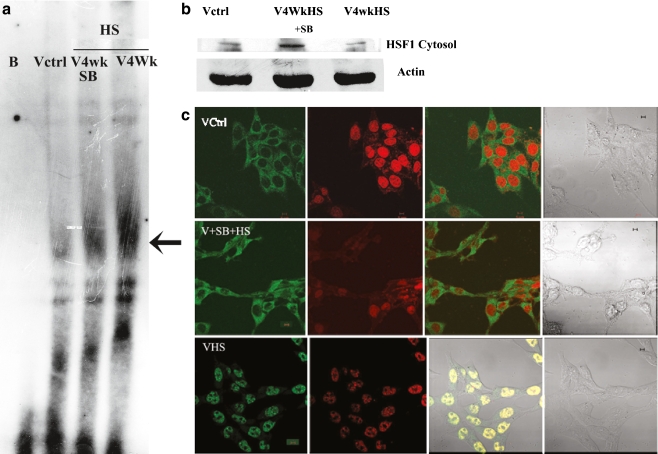Fig. 3.
Effect of SB203580 on the DNA binding activity and cellular localization of heat shock factor 1 (HSF1) in V79 fibroblasts exposed to chronic heat stress. a Electrophoretic Mobility Shift Assay (EMSA) showing HSF1 DNA-binding activity in V79 fibroblasts is provided. Cells were either left untreated (Vctrl), treated with chronic heat stress (V4WkHS), or treated simultaneously with chronic heat shock and 5 µM SB203580 (V4WkHS + SB). Nuclear extracts from these differently treated cells were used for the EMSA. BL Blank without nuclear extract. Arrow indicates HSF1-DNA binding. b Cytosolic localization of HSF1.Upper panel shows HSF1 bands from cytosolic extracts of differently treated cells. Lower panel displays beta-actin to indicate protein loading. Cells were either left untreated (Vctrl), treated with chronic heat stress(V4WkHS) or treated simultaneously with chronic heat shock and 5 µM SB203580 (V4WkHS + SB). c Cellular localization of HSF1 in chronic heat stressed V79 cells by confocal microscopy. Upper panel—Vctrl-untreated V79 cells, middle panel VHS + SB–chronic heat stressed V79 cells treated simultaneously with 5 µM SB203580, lower panel—VHS-chronic heat-stressed cells; micrographs on the left hand side of all panels show cells processed for visualization of HSF1 with secondary antibody–FITC conjugate. The second from left micrographs on all panels show cells processed for visualization of the nucleus with the DNA stain propidium iodide (PI).The third from left micrograph on all panels depict a merger of the FITC and propidium iodide signal. The fourth from left micrograph on all panels show differential interference contrast (DIC) from the same fields. After permeabilization and fixation, cells were treated with anti-HSF1 antibody and subsequently with FITC tagged secondary antibody and PI. The bar is 10 µm. The micrographs are representative of two separate experiments. The cells were treated with chronic heat stress for 4 weeks or were left untreated (control). The chronic heat stressed cells received either no other treatments or received simultaneous treatments with 5 µM SB203580. Experimental details are provided in the “Materials and methods” section

